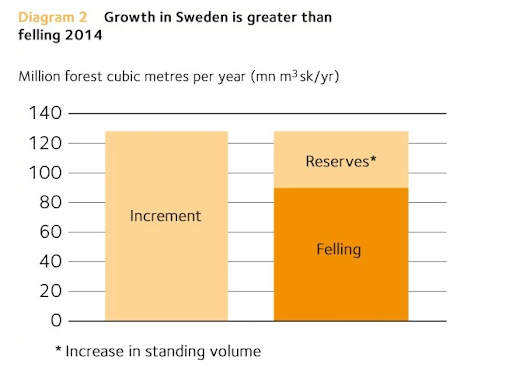Sweden’s forests have doubled in size over the last 100 years
Sweden is a land of trees. More than 70% of its landscape is covered by forest and in less than 100 years, Sweden’s forest assets have doubled.
Yet this is also a country where chopping down trees is big business. Sweden holds just under 1% of the world’s commercial forest areas and provides 10% of the sawn timber, pulp and paper that is traded on the global market.
Far from being a logged wasteland, however, Sweden has more forest now than it did a century ago – when it had only a fraction of its current population and globalisation didn’t exist.
So, how has Sweden managed to grow its timber industry as well as its level of tree cover?
The simple answer is that Sweden grows more trees than it chops down.
Annual growth stands at around 120 million forest cubic metres, and each year around 90 million forest cubic metres of that growth is harvested. That’s because Sweden employs a sustainable forestry model.
After decades of decline in Sweden’s forest in the 19th century, caused by farming, housing construction, wood for fuel, charcoal for the iron industry, and later as a source of logs for timber and pulping, the first Forestry Act was passed in 1903 with the intention of reversing the decline.
Since then, for every tree that was chopped down, another had to be planted. In addition, the legislation also limited the amount of timber that could be harvested.
While Sweden recognises the importance of wood to its national economy – the forestry industry employs over 60,000 people directly and is indirectly responsible for around 200,000 jobs – the government wanted to make sure that commercial timber production and forest biodiversity were given equal importance. In 1993, Sweden made its forests “a national resource”, making sure that the industry was both economically, socially and environmentally sustainable.
Threats to biodiversity
Despite all the positive statistics, Sweden’s forestry policies and timber industry are not without their critics. As forest cover is increasing, the levels of biodiversity appear to be reducing.
Almost all the forest in Sweden can be defined as cultured forest, which means forest that is cultivated and managed. Only the northernmost mountain regions have areas of virgin forest, areas that have not been affected by agriculture or silviculture.
-
That’s a remarkable amount of work hours for a single machine, the Norcar 600 owned by Erkki Rinne is taken well care of, it even has the original Diesel engine.
-
Kieran Anders is a forestry contractor working in the lake district. His work involves hand cutting and extracting timber using a skidder and tractor-trailer forwarder.
-
It is not possible to eliminate chain shot, but there are simple steps that can be taken to reduce the risk.
-
Arwel takes great pride in the fact that the mill has no waste whatsoever, “the peelings are used for children’s playgrounds, gardens and for farm animals in barns in the winter and the sawdust has multiple uses in gardens and farms as well.
-
Timber hauliers need to encourage young blood in, and also look after the hauliers we have, we need make the sector a safe and positive place to work.
FIND US ON
Forest Machine Magazine is written and edited by a forest professional with over 40 years hands on experience. We are dedicated to keeping you informed with all the latest news, views and reviews from our industry.
To support us you can subscribe to our bi-monthly magazine which is delivered to your door from only £30 per year.
Subscribe here
#homeoflogging #writtenbyloggersforloggers #loggingallovertheworld
-
 Issue 38£6.00
Issue 38£6.00


